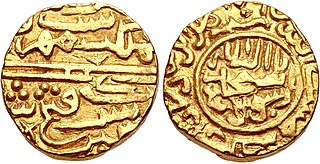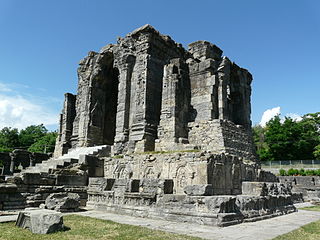Related Research Articles
This article contains information about the literary events and publications of 1642.
Literature of Kashmir has a long history, the oldest texts having been composed in the Sanskrit language. Early names include Patanjali, the author of the Mahābhāṣya commentary on Pāṇini's grammar, suggested by some to have been the same to write the Hindu treatise known as the Yogasutra, and Dridhbala, who revised the Charaka Samhita of Ayurveda.

The history of Kashmir is intertwined with the history of the broader Indian subcontinent and the surrounding regions, comprising the areas of Central Asia, South Asia and East Asia. Historically, Kashmir referred to the Kashmir Valley. Today, it denotes a larger area that includes the Indian-administered union territories of Jammu and Kashmir and Ladakh, the Pakistan-administered territories of Azad Kashmir and Gilgit-Baltistan, and the Chinese-administered regions of Aksai Chin and the Trans-Karakoram Tract.

Yamīn-ud-Dawla Abul-Qāṣim Maḥmūd ibn Sebüktegīn, usually known as Mahmud of Ghazni or Mahmud Ghaznavi, was the founder of the Turkic Ghaznavid dynasty, ruling from 998 to 1030. At the time of his death, his kingdom had been transformed into an extensive military empire, which extended from northwestern Iran proper to the Punjab in the Indian subcontinent, Khwarazm in Transoxiana, and Makran.
Sikandar Shah was the sixth sultan of the Shah Miri dynasty of Kashmir from 1389 to 1413.
Firishta or Ferešte, full name Muhammad Qasim Hindu Shah Astarabadi, was a Persian historian, who later settled in India and served the Deccan Sultans as their court historian. He was born in 1560 and died in 1620. The name Firishta means 'angel' in Persian.
The History of India, as Told by Its Own Historians is a book comprising translations of medieval Persian chronicles based on the work of Henry Miers Elliot. It was originally published as a set of eight volumes between 1867-1877 in London. The translations were in part overseen by Elliot, whose efforts were then extended and edited posthumously by John Dowson.

Kashmiri cuisine is the cuisine of the Kashmir Valley in the Indian subcontinent. Kashmiris have developed the art of cooking to a very high degree of sophistication and evolved a cuisine quite distinct from that of any part of the world. Rice is their staple food and has been so since ancient times. The equivalent for the phrase bread and butter in Kashmiri is haakh-batta. Meat along with rice, some vegetables and salad are prepared on special occasions like Eid. A typical everyday Kashmiri meal — lunch and dinner — consists of a generous serving of rice, mutton and vegetables cooked in oil, and yoghurt.

The Shah Mir dynasty was a dynasty that ruled the region of Kashmir in the Asian subcontinent. The dynasty is named after its founder, Shah Mir. During the rule of the dynasty from 1339 to 1561, Islam firmly established in Kashmir.

Kashmiris are an Indo-Aryan ethnolinguistic group speaking the Kashmiri language, living mostly, but not exclusively, in the Kashmir Valley in the Indian subcontinent.
Kashmiri Muslims are ethnic Kashmiris who practice Islam and are native to the Kashmir Valley in Indian-administered Kashmir. The majority of Kashmiri Muslims are Sunni. They refer to themselves as "Koshur" in their mother language.
Islam is the major religion which is practiced in Kashmir, with 97.16% of the region's population identified as Muslims, as of 2014. The religion - Islam, came to the region with the arrival any of Muslim Sufis preachers from Central Asia and Persia, beginning in the early 14th century. The majority of Kashmiri Muslims are Sunni Muslims and Shias account for less than 10 % of Muslim Population. They refer to themselves as "Koshur" in their mother language. Non-Kashmiri Muslims in Kashmir include semi-nomadic cowherds and shepherds, belonging to the 𝙂𝙪𝙟𝙟𝙖𝙧𝙨 and Bakarwal communities.

The Martand Sun Temple is a Hindu temple located near the city of Anantnag in the Kashmir Valley of Jammu and Kashmir, India. It dates back to the eighth century AD and was dedicated to Surya, the chief solar deity in Hinduism; Surya is also known by the Sanskrit-language synonym Martand. The temple was destroyed by Sikandar Shah Miri.
Sadruddin Shah, also known as Rinchan, was the first Muslim ruler of Kashmir. He ruled Kashmir from 1320 to 1323.
Mullah Nadri or Mulla Nasiri was a Persian-language poet in Kashmir during the reign of Sultan Sikandar and then at the court of Zain-ul-Abidin (1423–1473).
The Tarikh-i-Kashmir refers to several history books of Kashmir's Sultanate period, some of them lost and partially used as sources for the others.
Khulasat-ut-Tawarikh is a Persian language chronicle written by Sujan Rai in the Mughal Empire of present-day India. It deals with the history of Hindustan, and also contains details about the contemporary Mughal Empire. The author completed the work in 1695 CE, during the reign of Aurangzeb. An insertion about Aurangzeb's death was later added to the original copy by a transcriber.
Baharistan-i-shahi is a chronicle of medieval Kashmir. The Persian manuscript was written by an anonymous author, presumably in 1614.
K. N. Pandita, also known as Kashi Nath Pandita, is an Indian Kashmiri scholar in Persian and Central Asian Studies. Born in Jammu & Kashmir, Pandita studied and worked at Panjab University and University of Tehran, taught at the University of Kashmir and was the former professor and director at the Center of Central Asian Studies at the University of Kashmir. He was awarded UGC Emeritus Fellowship in Central Asian Studies 1978–88, and was awarded by the President and Vice President of India in 1985 and 1987 (respectively) for his academic attainments. He was a recipient of the Padma Shri in literature and education in 2017.

The Chak dynasty was a dynasty that ruled the region of Kashmir after the Shah Mir dynasty. The origins of the Chaks are unclear, they are said to be native Kashmiris of Dardic origin. The Chak dynasty ruled from 1561 to 1586. Ghazi Chak is referred as the first Chak ruler. The dynasty rose to power after the death of the Turco-Mongol military general, Mirza Muhammad Haidar Dughlat.